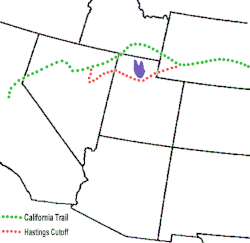Hastings Cutoff
| Hastings Cutoff | |
|---|---|

Route of the California Trail and Hastings Cutoff in the western United States.
|
|
| Location | Humboldt River Basin, Elko County |
| Official name: West End of Hastings Cutoff | |
| Reference no. | 3 |
The Hastings Cutoff was an alternative route for westward emigrants to travel to California, as proposed by Lansford Hastings in The Emigrant's Guide to Oregon and California. The ill-fated Donner Party famously took that route.
A sentence in Hastings' guidebook briefly describes the cutoff:
The most direct route, for the California emigrants, would be to leave the Oregon route, at Fort Bridger; thence bearing West Southwest, to the Salt Lake; and thence continuing down to the bay of St. Francisco, by the route just described.
The cutoff left the Oregon Trail at Fort Bridger in Wyoming, passed through the Wasatch Range, across the Great Salt Lake Desert, an 80-mile waterless drive, looped around the Ruby Mountains, and rejoined the California Trail about seven miles west of modern Elko (also Emigrant Pass).
The west end of the cutoff is marked as Nevada Historical Marker 3.
Hastings led a small party overland late in 1845 and spent the winter in California. Significantly, his stay at Sutter's Fort coincided with a visit by John C. Frémont, who had just explored the Great Salt Lake Desert and whose letter describing a new route to California would be widely published in Eastern newspapers. In April, Hastings set out with a few companions to meet the emigration of 1846. He stayed in the vicinity of the Sweetwater River while an eastbound traveler carried his open letter inviting emigrants on the California Trail to meet him at Fort Bridger. Between 60 and 75 wagons did so and traveled with Hastings on his cutoff. They endured a difficult descent down Weber Canyon, a waterless drive of 80 miles across the Great Salt Lake Desert, and a lengthy detour around the Ruby Mountains. Despite the usual trials of overland travel, they arrived safely in California.
...
Wikipedia
